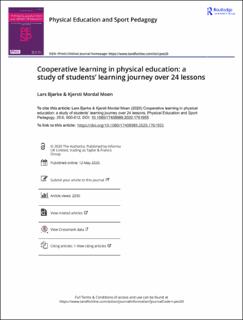Cooperative learning in physical education: a study of students? learning journey over 24 lessons
Peer reviewed, Journal article
Published version

View/
Date
2020Metadata
Show full item recordCollections
Original version
10.1080/17408989.2020.1761955Abstract
Background: Although a review of literature on Cooperative Learning (CL) in Physical Education (PE) has shown that CL can facilitate student learning in all legitimate learning domains for PE [Casey, A., and V. A. Goodyear. 2015. “Can Cooperative Learning Achieve the Four Learning Outcomes of Physical Education? A Review of Literature.” Quest 67 (1): 56–72. doi:10.1080/00336297.2014.984733], we need further knowledge about student learning which results from the sustained implementation of the model beyond the initial unit. Purpose: This paper draws on 24 lessons of CL over two academic years investigating students’ learning journey through (a) teachers’ perceptions on students’ learning journey through CL, and (b) students’ experiences of their learning journey through CL. Method: The study is part of a larger participatory action research project and follows students through four related six-week interventions in PE. The study draws on different data sources such as interviews, observation notes and the researcher’s reflective diary in order to acquire an in-depth understanding of students’ learning journey. Through first author’s close presence throughout the project, Lars was very familiar with the data. Hence, the analysis adopted an abductive approach [Alvesson, M., and K. Sköldberg. 2018 Reflexive Methodology: New Vistas for Qualitative Research. 3rd ed. Los Angeles, CA: Sage] in which the empirical data were examined with the aid of pre-established theoretical concepts. Findings: Three themes emerged from the analysis. The first, ‘shifting attitudes’ highlighted how students changed their attitudes towards CL from being reluctant to positive. The second, ‘the influence of having learning objectives’ shows that working systematically with learning objectives over time, helped students understand that physical education is, in fact, a subject for learning. The final theme, ‘social- and emotional learning’, identified aspects of students’ learning that eventually results in all students being capable of working alongside their peers to master academic tasks in physical education. Conclusion: After experiencing learning through CL as meaningful, many students developed a positive attitude towards CL and working with their peers in small groups. The paper shows that having learning objectives is something most students appreciate and value. Nevertheless, working with learning objectives must be undertaken systematically over time so that students understand that they are expected to learn in physical education. While other studies have suggested that it took a few weeks for students to work comfortably together [Casey, A., B. Dyson, and A. Campbell. 2009. “Action Research in Physical Education: Focusing Beyond Myself Through Cooperative Learning.” Educational Action Research 17 (3): 407–423. doi:10.1080/09650790903093508], students in this project required up to 17 lessons before they were able to function in their groups. At the same time, all students, with different motor, social, cognitive and affective challenges, can be capable of learning through CL. However, this did not happen by chance, and the teacher must carefully adapt the delivery of the CL model to meet the needs of all students.
